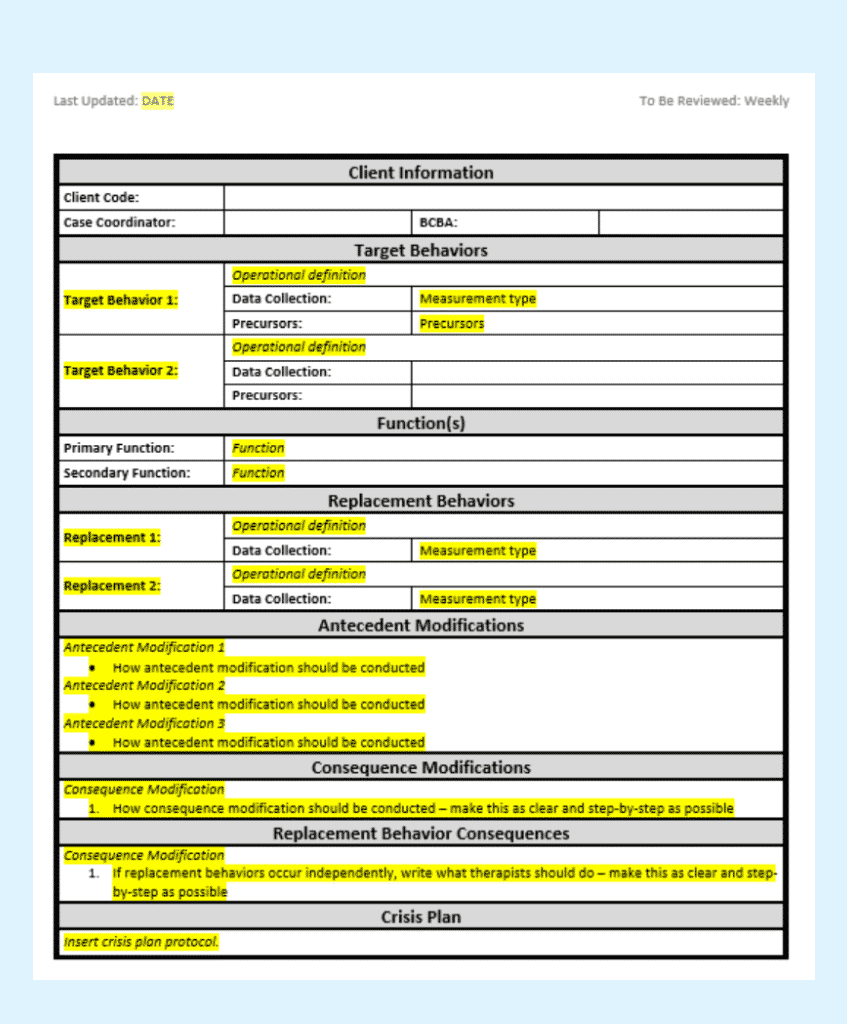Every behavior intervention plan (BIP) should include a section on replacement behaviors, which teaches the client how to get reinforcers in a more suitable way than through problem behavior. For example, if a client throws tantrums to gain access to favored activities, a substitute behavior could include requesting appropriate for preferred activities instead.
The operational characterization of the issue behavior should always be included in the behavior intervention plan (BlP). This enables therapists to obtain reliable data on the behavior and administer appropriate consequences as soon as the problem behavior arises. The operational definition is a description of the issue behavior that should only contain objective, measurable action verbs like the one in the sample.
The escape function outlines how nonpreferred stimuli are removed to preserve behavior. The term "escape" implies the purpose of the behavior. The term "escape" refers to socially influenced outcomes. A socially-mediated demand, for example, is when a parent says, "Go finish your homework." It is then escape if the client tantrums and the parent gives up on the demand. This is distinct from automatic, which involves non-socially influenced outcomes. For example, if you have a headache and take medication, the headache will go away. It is not socially mediated because no one else is involved, hence it is automatic rather than escape.
The term "automatic" refers to a function in which the behavior generates its own reinforcer (e.g., playing with the hair automatically produces the desirable consequence). A "positive" function indicates the addition of a stimulus (e.g., playing with hair presents a pleasurable sensation). As a result, the hypothetical function of the behavior is always positive.
The behavior intervention plan's (BIP) consequence changes section defines how to respond once a problem behavior occurs, and it usually includes an extinction component. Therapists may also try to elicit substitute behaviors. Although "Replacement behaviors" is a close second, the sample does not specify which replacement behaviors should be addressed. As a result, that option is incorrect.
A "social" consequence is one that is delivered by another person. A stimulus is eliminated after the behavior is "negative." The escape function explains behavior that is maintained after socially mediated expectations are removed. It would be escape if a client was requested to tidy his room and then threw a tantrum, and the parent gave up on the demand (e.g., social negative reinforcement).

A behavior intervention plan template is shown in the diagram (BIP). It has all of the main components of a behavior reduction plan, including operational definitions of target behavior(s), replacement behavior(s), antecedent and consequence adjustments, issue behavior function(s), and crisis strategy.
Advertisement
Another person mediates the result of the behavior in a "social" function (e.g., SIB occurs, then the caregivers deliver a stimulus). A "positive" function indicates the addition of a stimulus (e.g., SIB occurs, then caregivers present a reprimand). As a result, the imagined function of the behavior is socially good (AKA attention).
Antecedent modifications are procedures that are conducted prior to the occurrence of a problem behavior and are intended to prevent the occurrence of a problem behavior in the first place. Implement choice protocols are incorporated in this behavior intervention plan (BIP) to help prevent noncompliance.
The term "automatic" refers to a function in which the behavior generates its own reinforcer (e.g., Jackie takes medication for migraines herself). A "negative" function denotes the absence of a stimulus (e.g., taking the medication decreases the severity of the migraine). As a result, the hypothesized function of migraine medicine is always negative.
Another person mediates the result of the behavior in a "social" function (e.g., hitting occurs and changes the behavior of Angel or their parents). A "negative" function denotes the absence of a stimulus (e.g., hitting results in the little brother leaving or being taken away by parents). As a result, the imagined function of the act is socially unfavorable.
The crisis plan outlines what to do in the event of a behavioral emergency. A behavioral emergency occurs when the client or others could be in danger. The crisis plan is included exclusively to ensure safety and is not part of the main therapeutic treatment plan. Physical restraint is not used as the primary treatment in this case; rather, it is used only if it is regarded safer than allowing problem conduct to continue. Physical restraint is not employed when the client or others are not in danger. Physical constraint is also not recommended because it does not teach any substitute behaviour.
The frequency with which Jay shouts "NO" can be simply counted in order to determine the possible origin of the habit. It is simpler to concentrate on Jay's screaming because it is an observable behavior as opposed to a quantifiable one.
The delivered stimulus is enjoyable to the customer, which causes the behavior to wane over time. The client will become more motivated to do well once they learn that if they finish one assignment, they might receive access to something they want. An illustration of constructive punishment is this.
Advertisement
As the RBT, it is your responsibility to execute all of the BCBA's programming. You desire that your client learn as much as they can. Your client will learn the skill and retain it in their repertoire if new demands and objectives are presented to them repeatedly.
To demonstrate to your client that you can be entertaining and that you enjoy playing with toys as well, preference assessments are crucial. You will gain from it when you are manding as well because of the great incentive. As you're commanding, your client will discover that you may have fun with them while also teaching them new abilities. "What color is the block, for instance?" or "Could you stack the block?are abilities that your client will find useful.
Click for the next Free RBT Test